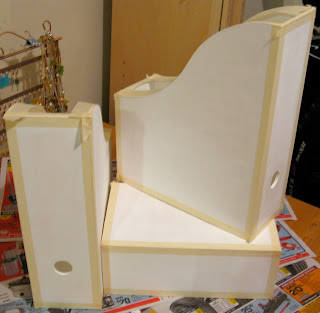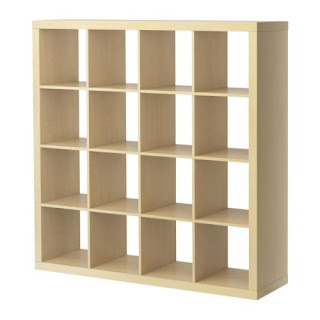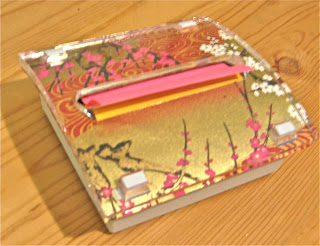If you've never seen their products before and like color then SEEK THESE OFFICE SUPPLIES OUT! Seriously, this company gets how to make sleek office supples in a rainbow of color options in a way no one else seems to. Unfortunately their products aren't particularily cheap. They aren't ridiculous, but they're in a mid-range that's a little bit out of my range right now, at least if I want to do my entire home office in their line.
My plan is to slowly but surely pick up a few pieces here and there (in the magenta and grass green colors if you were wondering) and eventually have a home office that's all Semikolon or things that match Semikolon... in, like, 10 years or so because really... this stuff is frustratingly priced. It's priced low enough that I can actually buy it, but high enough that I can't buy much of it at any time. Ah well, I should just be happy it exists and just eventually resort to petty crime so I can afford the overpriced secretary they make.
I was in need of some magazine files, but the Semikolon ones were just a bit too steep for me at the time. Thankfully I bumped into some extremely cheap wooden magazine files at Ikea: Knuff. They were on sale for $3.99 each, so I snatched up three. In retrospect I should have bought more since my Ikea no loger carries these exact ones, but what can you do? It's hard to go to Ikea and not spend eight times what you meant to... I was trying to be vaguely fiscally responsible.
Wood is great because you can paint it quickly without a lot of drama. I figured it wouldn't be too hard to make these puppies look like the Semikolon magazine files I longed for.
 The first step was to prime the files. Untreated wood is exceptionally thirsty. If you try to use acrylic paint directly on wood you'll find that you'll have to use tons of it because the wood soaks up a large amount of the water in the paint quickly, so it won't spread very far before you have to reload your paintbrush. The best way to combat this is to do a primer coat. Primer paint is significantly cheaper than regular paint, so you can use a lot without spending a lot. It also creates a smooth surface that your paint will adhere well to. In this case I used gesso, a primer used on canvas, to prime my boxes. Why gesso? Because it's a cheap primer and I had a bunch already sitting in a box wanting something to do. You can pick up a reasonably-sized jar of gesso at art and craft supply stores. For projects like this don't bother with fancy gesso; you just need the most basic one you can find. Liquitex Basics brand gesso is fine, or any other gesso around the $5-10 price point. A small container should be enough. I used maybe 1/4th of the container you can see in the picture on these files.
The first step was to prime the files. Untreated wood is exceptionally thirsty. If you try to use acrylic paint directly on wood you'll find that you'll have to use tons of it because the wood soaks up a large amount of the water in the paint quickly, so it won't spread very far before you have to reload your paintbrush. The best way to combat this is to do a primer coat. Primer paint is significantly cheaper than regular paint, so you can use a lot without spending a lot. It also creates a smooth surface that your paint will adhere well to. In this case I used gesso, a primer used on canvas, to prime my boxes. Why gesso? Because it's a cheap primer and I had a bunch already sitting in a box wanting something to do. You can pick up a reasonably-sized jar of gesso at art and craft supply stores. For projects like this don't bother with fancy gesso; you just need the most basic one you can find. Liquitex Basics brand gesso is fine, or any other gesso around the $5-10 price point. A small container should be enough. I used maybe 1/4th of the container you can see in the picture on these files.Prime the entire file, inside and out (unless you're planning to leave parts unfinished. Mask those parts off with tape before you prime if you're going this route). I started by doing the bottoms, waiting for them to dry, and then priming everything else. If you end up with any dried gesso lumps (which I did since my gesso was old and a bit dehydrated) you can use a fine grade piece of sandpaper to lightly sand them out.
Once the priming is done now you can break out the paint. Primer is not an attractive finish, so I highly recommend that you paint overtop of it, even if you're planning to stay the same color as the primer. While paint primer has a nicer color than car primer (ewww... primer grey and brown... I shudder just thinking of the cars that drive around painted in just primer), it still has an unfortunate flat finish that doesn't have the richness of a proper acrylic paint. Take the extra time and paint over every speck of it.
For this project I wanted to simulate the white borders of the Semikolon products on my files, so I took white acrylic paint and painted all of the edges a bit beyond where I thought the bands of white would be (having some paint overlap is a good thing). Preciseness was unnecessary at this point since I was going to be masking off things in the next coat. Expensive paint was unnecessary too... I just used cheap Liquitex Basics paint. You're not painting a masterpiece... you just need a basic color with good performance, which the Liquitex Basics brand provides.
After I painted the white edges I then masked them off with masking tape. Rather than using a ruler and precisely masking off a set measurement I just used thinner masking tape and, by eye, placed it so half the tape was on one side, and the other half was on the other. It's not that hard really... people are somewhat decent at cutting things in half by eye.
When you're placing the masking tape (or painter's tape if you have it) make sure you press it down on the file very firmly. You don't want it to accidentally peel off while you're painting the main color. Don't worry, even if you press it down firmly it'll still peel off without pulling up your paint.
Now that your white corners are masked off, get your main color ready. If you can purchase your main color premixed either in a tube from an art supply store or mini pail from a home renovation store do this. It's way easier than trying to guesstimate how much you'll need and premixing it or, even worse, trying to remix the same color again after you've run out mid-project (which I had to do on this project... I made it work, but it SUCKED to have to so). I didn't realize this when I was doing this project, but at places like Home Depot you can buy small containers of their wall paint fr about $5 mixed to any of the paint chips they have. This is supposed to be for trying out a color on your wall or something, but there's no reason you can't use it on a project like this to get the exact color you want. Depending on how dark your color is you may need to do two coats (darker usually equals more coats to get the color even).
When your paint is partially dry you can peel off the masking tape. If you're using house paint this isn't as crucial, but art paint sometimes doesn't peel off cleanly if you take off the masking tape once it's completely dry. The part attached to whatever you painted can sometimes stay attached to what's on the tape, so when you pull the tape off it makes the edge ragged. Make any small paint touchups you need to.
After the paint fully dries you're done. Semikolon-look, but MUCH cheaper (especially if you already have the paint and supplies)
Final project cost to me: $12
Time to complete project: About 2 hours spaced over many small painting sessions
Time to complete project: About 2 hours spaced over many small painting sessions


































